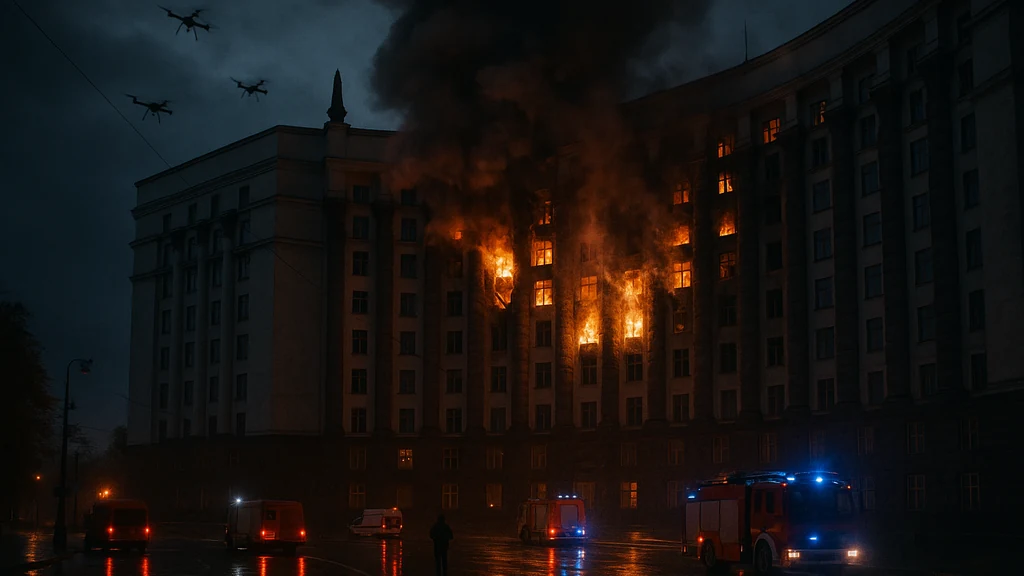Russia's largest air attack on Ukraine unfolded overnight, threatening Kyiv with hundreds of drones and missiles. See responses, casualties, and aid.
Quick Answer
Russia's largest air attack on Ukraine unfolded overnight, officials say, with roughly 805 drones and 13 missiles fired. Kyiv’s Cabinet of Ministers building was damaged and set ablaze for the first time in the war, while residential areas across Kyiv and other cities suffered severe hits. At least four people were killed, including an infant, and dozens were injured as air-raid alerts stretched for hours across Odesa, Kryvyi Rih, Zaporizhzhia, Sumy, and Chernihiv. President Zelenskiy condemned the barrage and urged stronger Western air defenses, as allied leaders signaled support and the United States considered new sanctions. Ukraine also said it struck parts of Russia’s energy infrastructure, including the Druzhba pipeline, in apparent retaliation. This marks a sharp escalation in Moscow’s aerial campaign and dominates today’s global news cycle.

Key Takeaway: The attack signals a dramatic escalation in Moscow’s aerial campaign and tests Western air defenses and sanctions regimes, while civilians bear the brunt of the violence.
Complete Guide to Russia's largest air attack on Ukraine
In the hours after the strike, a complex picture emerged of scale, impact, and international reaction. The numbers cited by officials — 805 drones and 13 missiles in a single overnight assault — underscore a coordinated, massed-air campaign designed to overwhelm defenses and deliver symbolic and strategic blows. The strike’s most dramatic images center on Kyiv, where the Cabinet of Ministers building was damaged and set alight, a stark rupture in the city’s daily rhythm and a jolt to the political heart of Ukraine.
-
Overview of the assault
- The operation involved an unprecedented volume of munitions and unmanned systems, a hallmark of modern multi-domain warfare. Officials said the drone swarm and missile barrage covered multiple regions in a single night, intensifying air-raid alerts in a way not seen since the invasion began.
- Casualties highlighted the war’s human cost: at least four deaths, including an infant, and dozens of injuries. The human toll compounds the psychological strain on civilians already living with disruption and displacement.
- Kyiv’s government district became a symbol of the strike’s audacity and its risk to governance in wartime. The Cabinet of Ministers building’s damage prompted urgent security and evacuation considerations within the city.
- Ukraine’s leadership framed the attack as evidence of Russia’s widening capabilities and resolve, while Kyiv called for more robust Western air defenses to prevent future incursions.
-
City-by-city impact
- Kyiv: The epicenter of the drama, with the government building ablaze and surrounding neighborhoods hit by debris and fire. Sirens persisted for hours as emergency crews battled fires and secured roads for responders.
- Odesa: Coastal city alerts and strikes in the region disrupted port activities and damaged civilian infrastructure, raising concerns about energy and logistics routes along the Black Sea.
- Kryvyi Rih, Zaporizhzhia, Sumy, Chernihiv: Each city reported air raid alerts and damage in residential and commercial areas, highlighting the broad geographic footprint of the attack.
- Across the affected regions, critical infrastructure—power, water, and communications—suffered intermittent outages, complicating emergency response and daily life.
-
Damage to key infrastructure and symbolism
- The Cabinet of Ministers building in Kyiv bore a symbolic hit, reflecting the attack’s intention to target the political center and to project a sense of vulnerability.
- Reports suggested damage to energy and civil infrastructure in several locales, with the Druzhba pipeline feature entering discussions as Ukraine framed retaliatory actions against Russia’s energy systems.
-
International response and sanctions posture
- Zelenskiy condemned the barrage and pressed Western allies for faster and deeper air-defense aid, signaling patience wearing thin in the face of continued threats.
- European leaders signaled support, while the United States weighed additional sanctions and military assistance to Kyiv, recognizing the broader implications for European security and NATO deterrence.
- The strike prompted renewed debate in Western capitals about the speed and scale of aid, including Patriot and other advanced air-defense systems, and the need to diversify interception capabilities.
-
Ukraine’s retaliation and energy targets
- Kyiv asserted that Ukraine struck parts of Russia’s energy infrastructure in apparent retaliation, including the Druzhba oil pipeline. The escalation of cross-border energy actions raises questions about escalation dynamics, retaliation ethics, and the risk of further cycles of escalation.
- Analysts note that energy-system targets could influence Russia’s short-term strategic calculations, as Moscow seeks to deter Ukrainian operations while Kyiv seeks to degrade Russia’s war-fighting capabilities.
-
The broader strategic context
- The attack aligns with a broader pattern of intensified aerial activity in the conflict, signaling a potential shift toward larger-scale, synchronized air campaigns by Russia.
- Western defense planning now faces renewed emphasis on air defense integration, multi-layered detection, and faster decision cycles to counter mass drone swarms and long-range missiles.
- For Ukraine, the event compounds the challenge of sustaining civilian welfare and governance under bombardment while maintaining international diplomatic support and international humanitarian corridors.
-
Practical implications for civilians
- Civilian resilience is being tested as sheltering, medical care, and essential services scramble to adapt to repeated alarms and intermittent power losses.
- The event highlights the importance of domestic mental health resources, community support networks, and public messaging that helps families cope with repeated shocks in urban environments.
Key Takeaway: The attack’s scale and symbolism push war-time governance, civilian safety, and international support into sharper relief, underscoring the need for rapid, coordinated air defense and durable diplomatic backing.
Related topics for internal linking: Russia-Ukraine war escalation, drone and missile warfare, energy infrastructure targeting, Druzhba pipeline, Western air defense aid, NATO deterrence, civilian resilience, emergency response, international sanctions, energy security in Europe.
Why This Matters
In the wake of the attack, the question is not only what happened, but why it matters in the long arc of the conflict and European security. The overnight assault is being read as a strategic move by Moscow to demonstrate reach, disrupt governance, and test the resilience of Ukrainian civilians and Western allies. Observers note several trends shaping the significance of this event.
-
Strategic implications
- The use of a large drone and missiles mix signals a capability to saturate air defenses and create windows for devastating impact on political and civilian targets.
- The attack amplifies the debate in Western capitals about the speed and volume of military aid to Kyiv, including the timing of advanced air-defense systems such as Patriot batteries and NASAMS, and the long-term viability of deterrence strategies.
- Russia’s actions could influence energy-security calculations in Europe, given the Druzhba pipeline’s role in supplying refineries and industrial users, and the risk of reciprocal strikes on energy infrastructure across borders.
-
Human and societal impact
- Civilian casualties, including an infant, underscore the indiscriminate human cost of modern warfare and the deep trauma inflicted on families and communities.
- Repeated air-raid alerts disrupt schooling, work, and medical access, with long-term implications for mental health and social cohesion.
-
Diplomatic and policy trajectories
- Western leaders’ responses will shape sanctions architecture, export controls, and potential escalation management tools aimed at constraining Moscow while preserving Kyiv’s ability to defend itself.
- The event could accelerate discussions around risk-sharing, intelligence-sharing, and interoperability of defense systems across allied nations.
-
Data and verification challenges
- As with any fast-moving crisis, figures (drone counts, missile types, casualty numbers) may shift as more information becomes available. The reporting emphasizes the need for transparent, verifiable data to guide policy decisions and humanitarian responses.
Key Takeaway: This event tests the cohesion of Western defense commitments, the resilience of Ukrainian society, and the international community’s willingness to sustain pressure on Moscow through sanctions and defense aid, while considering the humanitarian dimensions of a renewed heavy air campaign.
People Also Ask What happened in Kyiv during Russia's largest air attack?
- Kyiv faced a dramatic scene: a government building damaged and set on fire, widespread air-raid alerts, and fires within the urban core. The event underscored the city’s vulnerability in a major political center during an ongoing crisis, while emergency services worked to contain fires and provide aid to residents.
How many drones and missiles were fired in the attack on Ukraine?
- Officials reported roughly 805 drones and 13 missiles in the overnight attack, illustrating a large-scale, coordinated assault designed to overwhelm air defenses and maximize damage across multiple regions.
Which cities were hit in the latest Ukraine air strike?
- Kyiv, Odesa, Kryvyi Rih, Zaporizhzhia, Sumy, and Chernihiv were among the cities affected by the strikes and debris, with varying degrees of damage to residential and critical infrastructure and loud air-raid alerts across the country.
Did Kyiv's Cabinet of Ministers building catch fire?
- Yes. Kyiv’s Cabinet of Ministers building caught fire after sustaining damage in the strike. The incident became a focal point of international attention and symbolized the attack’s direct impact on Ukraine’s political leadership.
What is the status of Western air defense aid after the attack?
- Western leaders pledged support and discussed accelerating the deployment of advanced air-defense systems. The attack intensified debate in allied capitals about the speed and scale of new aid, including potential sanctions and arms shipments to Kyiv.
What happened to the Druzhba pipeline during the Ukraine-Russia conflict?
- Ukraine claimed retaliatory actions targeting parts of Russia’s energy infrastructure, including the Druzhba pipeline. The move reflects broader energy-security considerations and the risk of cross-border escalation in a protracted conflict.
How many casualties were reported from the attack?
- Official reports indicated at least four deaths, including an infant, with dozens more injured. The human cost highlights the ongoing danger to civilians and the urgent need for humanitarian support and mental-health resources.
Additional search-focused questions and context you might encounter:
- What types of weapons were used in the attack, and what does that imply for future defense planning?
- How are cities across Ukraine managing emergency services and civil protection in light of repeated air-raid alerts?
- What are the implications for energy security in Europe following the Druzhba-related claims?
- How might this event influence sanctions policy and allied defense commitments?
- What is the timeline of events from the first alert to the last reported strike?
Key Takeaway: The questions above reflect the breadth of public curiosity about tactics, civilian impact, and policy responses, all of which will shape ongoing coverage, aid decisions, and strategic debates in the coming days.
Related topics for internal linking (non-clickable):
- Russia-Ukraine war escalation strategies
- Drone swarm warfare and missile defense
- Kyiv political resilience during war
- Energy infrastructure targets and Druzhba pipeline security
- Western defense aid and sanctions dynamics
- Civilian protection and humanitarian response in war zones
- International diplomacy and NATO deterrence
- Crisis communication and public-safety messaging
- Cyber and information warfare in parallel with kinetic attacks
Final note in this section: The narrative around Russia's largest air attack on Ukraine is evolving. As officials refine casualty tallies and damage assessments, the emphasis remains on protecting civilians, shoring up defenses, and maintaining international resolve. The immediate aftermath will shape security policy, humanitarian operations, and the broader trajectory of the conflict in the weeks ahead.
Key Takeaway: The attack catalyzes a critical moment for security policy, civilian protection, and international coordination—its consequences will reverberate in defense planning, sanctions decisions, and humanitarian strategy for the near term.



